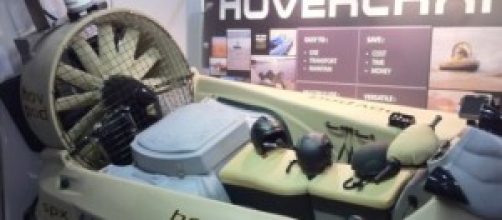Many vehicles and products evolve according to military requirements, and hovercraft are no exception - since their introduction hovercraft have evolved to grow in size and capability. New materials such as carbon fibre composites now offer rugged small combat hovercraft that can act as a swarm to deter infiltrators, terrorists and people/drug smugglers.
Many people are familiar with large Military hovercraft that are capable of carrying large numbers of personnel and armoured vehicles.
But size isn't everything - the new generation of smaller combat hovercraft have emerged to take advantage of new product developments such as advances in carbon fibre composites.
Smaller military hovercraft can be airlifted by helicopter into areas affected by flooding and other natural disasters, to deliver food, water treatment bottles and essential medicines. Water is heavy, water treatment bottles are light and can decontaminate flood waters to remove bacteria.
Carbon fibre composites are very strong yet lightweight, and since hovercraft are weight sensitive vehicles, carbon fibre composites deliver superior payloads that are low cost when compared to traditional aluminum built hovercraft.
Border Patrol.
Of course, military procurement officers would love to afford large military hovercraft situated every 20 miles or so along sensitive borders, to stop terrorists from carrying out Mumbai type terrorist threats.
But even military budgets have limits. And large hovercraft are too visible to allow them to keep a low profile.
Smaller combat hovercraft that carry 6-7 man crew are far more affordable, and like a swarm can deter infiltrators, detect people and drug smugglers in areas not effectively patrolled by larger vessels. For the price of a traditional military hovercraft, twenty or thirty combat hovercraft could provide far better coverage, and offer faster response time, since border miles can be divided by more craft, for more rapid response. Due to the lightweight properties of Carbon Fibre composites, combat hovercraft payloads are far more efficient, so collective weight payload can transport 4 or 5 times more weight per $ invested than the heavyweight traditional hovercraft.
Flood Rescue
Helicopters are often used during flood emergencies to help save people from drowning, but helicopters are not very efficient in rescue operations for a number of reasons. When waters rise, people tend to climb up trees and pylons - tree cover limits visibility and helicopter pilots are cautioned to keep well clear of pylons. Helicopters create 100 mile-an-hour downdraft winds, so need to use very long winch cables. Long winch cables take longer to deploy, how long can victims tread water before drowning? Helicopters are weight dependent, so it is crazy to use helicopters to deliver fresh drinking water, far better for smaller combat hovercraft to deliver water filtration systems that can clean water and remove contaminants and viruses.
Hov Pod Carbon Infinity
The Hov Pod Carbon Infinity is a 6-7 seater military hovercraft constructed from Carbon fibre Kevlar composite configured with 120HP Turbo engine and military cooling system. Hov Pod also manufacture unique HDPE hulls that are used for 3-4 man crews - both models can be modified to detect unexploded ordnance with ground survey equipment and GPS mapping software.
Versatility
Both models have been designed to be easy to transport by road or airlifted by helicopter, and can be configured to take night vision cameras, military comm's, GPS, RADAR, and other military equipment. Hovercraft are far more stable on water surfaces than RIBs, and can operate over mud, sand, ice and snow, or shallow fast running water.

